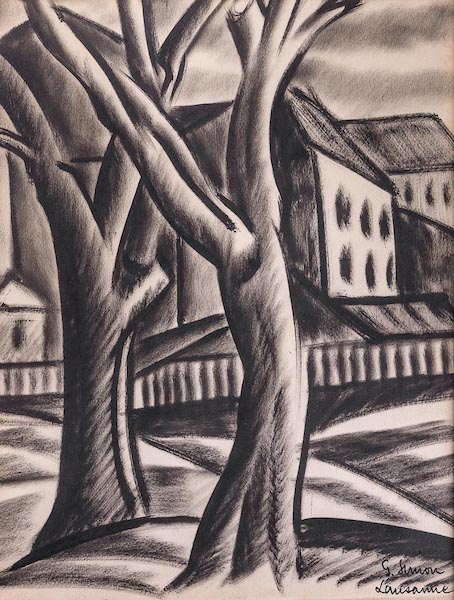Biography
Painter and sculptor Jean-Georges Simon was born Simon György János to a Transylvanian merchant family in the prominent port city of Trieste, Austro-Hungary (now Italy) in 1894, where his father was a businessman and Hungarian consul. However, he spent most of his childhood in Temesvár (Timișoara), Transylvania and in Budapest. In 1912, he enrolled at the Hungarian University of Technology to study Architecture, but he abandoned this course a year later to attend the Hungarian Academy of Fine Arts instead. Simon spent two summers (in 1913-14) at the Nagybánya (Baia Mare) artists' colony where he picked up the fashionable fauvist style. His career was interrupted by the First World War in which he served as a cavalry officer on the Russian front and was seriously wounded in 1917. Disillusioned by the turbulent situation in Hungary after the war, Simon studied variously in Vienna, Lausanne and Milan. His works were first featured in an international exhibition of modern art in Geneva in 1921. In the late 1920s Simon married his student, fellow Hungarian artist Klára Rudas, but the relationship did not last and they divorced a few years later. After spending some years in Switzerland waiting for his papers to arrive, Simon was eventually granted a French visa and moved to Paris, where he stayed until 1936. In the French capital, he took classes at the École des Beaux-Arts, Academie Colarossi and Academie Julian, and it was during this interwar period that he changed his name to the French form, Jean-Georges Simon.
In spring 1936 Simon relocated to London to study manuscripts in the British Museum, as he was interested in graphology. A few months later he met his future second wife, Patricia Frayling and the couple married in 1937 at St Mary Abbot's church in Kensington. They managed to spend a year abroad on honeymoon before the Second World War broke out, Simon due to open a solo exhibition in Brussels in 1938. They returned to London in early 1939 and rented a studio on Fulham Road where 'Jancsi', as he was known by close friends and family, strolled around the neighbourhood making sketches of the weary and despairing faces of wartime Londoners. Since both he and his wife, who adopted Hungarian citizenship, were treated as enemy aliens, they could not benefit from air raid precaution services (ARP) and had to flee London to the safety of a friend's cottage in Harrogate, in the Yorkshire Dales, in order to save their lives - and Simon's oeuvre - from bombing. Simon found a studio space in Harrogate where he produced paintings in a variety of styles and took up teaching at the local college of art; however, this move fractured Simon's career, as he had to sever his good connections to the inner circles of the art world in the capital. Even though he showed jointly with Constantin Guys at the prestigious Redfern Gallery in 1945, tried to establish a London studio again at Earl's Court, and sent pictures to the Royal Academy Summer exhibition in 1951, Simon failed to gain wide recognition for his work in England. He nevertheless continued to regularly exhibit in Hungary until 1941 and received the Mihály Zichy Prize for Graphic Art from the Pál Szinyei-Merse Society in 1940. Simon was also one of the 15 contemporary immigrant artists who were represented in the 1943 Hungarian Graphic Art exhibition held at the Hungarian Club in London, organised by Hungarian émigré, Charles Rosner.
Simon was active in Bradford and Harrogate until 1950, which were possibly his most fruitful years. Simon settled permanently in Harrogate in 1962 and took up sculpture, an early ambition as a student, furthering his technical knowledge by spending a few weeks in Paris and Italy each summer. He showed regularly in the north of England and was featured in a group show at Abbot Hall, Kendal in 1966. Jean-Georges Simon died in hospital in Leeds, England in 1968 and a memorial show was held at Wakefield's City Art Gallery in 1973. Despite having a circle of private patrons and supporters, the main body of Simon's oeuvre remained unsold after his death, and his work is not currently represented in UK public collections. Simon's artistic legacy was initially managed by his widow, who in 1986 assigned it to a close friend, Lois Smith, who organised and catalogued the works, along with a modest archive which is still maintained by her family and friends. Recently, Simon's career has been re-examined by Robert Waterhouse in his monograph of the artist entitled Jean-Georges Simon: Hungary to England – An Artist's Odyssey (2005) and his survey Their Safe Haven: Hungarian artists in Britain from the 1930s (2019), which was to be accompanied by a sadly-postponed exhibition at the Mercer Art Gallery, Harrogate. On 18 September 2021 a Harrogate Civic Society plaque commemorating Simon was unveiled at 4 Park Road, where he lived from 1952 until his death.

